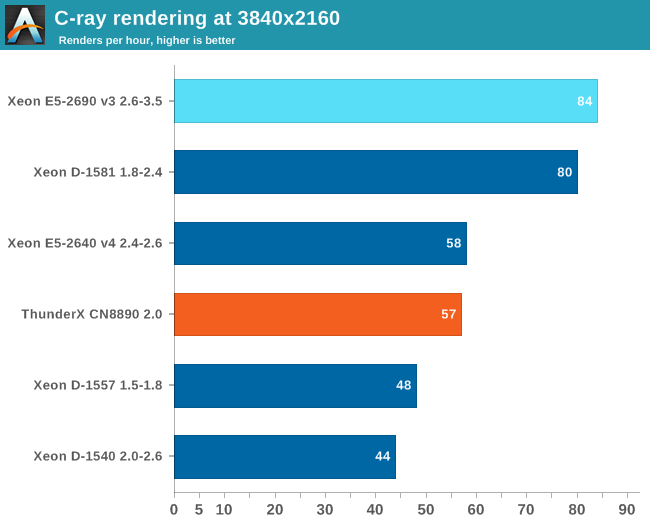Investigating Cavium's ThunderX: The First ARM Server SoC With Ambition
by Johan De Gelas on June 15, 2016 8:00 AM EST- Posted in
- SoCs
- IT Computing
- Enterprise
- Enterprise CPUs
- Microserver
- Cavium
Floating Point: C-ray
Shifting over from integer to floating point benchmarks we have C-ray. C-ray is an extremely simple ray-tracer which is not representative of any real world raytracing application. In fact, it is essentially a floating point benchmark that runs out the L1-cache. That said, it is not as synthetic and meaningless as Whetstone, as you can actually use the software to do simple raytracing. We use this benchmark because it allows us to isolate the FP performance and the energy consumption from other factors such as L2/L3 cache/memory subsystem.
We compiled the C-ray multi-threaded version with -O3 -ffast-math. Real floating point intensive applications tend to put the memory subsystem under pressure, and running a second thread makes it only worse. So we are used to seeing that many HPC applications perform worse with multi-threading on. But since C-ray runs mostly out of the L1-cache, we get different behavior.

This is the most favorable floating point benchmark that we could run on the ThunderX: it does not use the high latency blocking L2-cache, nor does it needs to access the DRAMs. Also, the Xeons cannot really fully flex their AVX muscles. So take this with a large grain of salt.
In these situations, the ThunderX performs like the midrange Xeon E5-2640 v4.










82 Comments
View All Comments
Daniel Egger - Wednesday, June 15, 2016 - link
I could hardly disagree more about the remote management of SuperMicro vs. HP. Remote management of HP is *the horror*, I've never seen worse and I've seen a lot. It's clunky, it requires a license to be useful (others do to but SuperMicro does not have such nonsense), the BCM tends to crash a lot (which is very annoying for a remote management solution), boot is even slower than all other systems I know due to the way they integrate the BIOS and remote management on the system and it also uses Java unless you have Windows machines around to use the .NET version.For the remote management alone I would chose SuperMicro over most other vendors any day.
JohanAnandtech - Thursday, June 16, 2016 - link
I found the .Net client of HP much less sluggish, and I have seen no crashing at all. I guess there is no optimal remote management client, but I really like the "boot into firmware" option that Intel implemented.rahvin - Thursday, June 16, 2016 - link
Not only that but Supermicro actually releases updates for their BCM's. I had the same shocked reaction to the HP claim. Started to wonder if I was the only one that thought supermicro was light years ahead in usability.I should note that Supermicro's awful Java tool works on Linux as well as windows. Though it refuses to run if your Java isn't the newest version available.
pencea - Wednesday, June 15, 2016 - link
All these articles and yet still no review for the GTX 1080, while other major sites have already posted their reviews of both 1070 & 1080. Guru3D already has 2 custom 1080 and a custom 1070 review up.Ryan Smith - Wednesday, June 15, 2016 - link
It'll be done when it's done.pencea - Wednesday, June 15, 2016 - link
Unacceptably late for something that should've been posted weeks ago.Meteor2 - Thursday, June 16, 2016 - link
Will anyone read it though? Your ad impressions are going to suffer.Ryan Smith - Thursday, June 16, 2016 - link
Maybe. Maybe not. But it's my own fault regardless. All I can do is get it done as soon as I reasonably can, and hope it's something you guys find useful.name99 - Thursday, June 16, 2016 - link
Give it a freaking rest. No-one is impressed by your constant whining about this.pencea - Thursday, June 16, 2016 - link
Not looking to impress anyone. As a long time viewer of this site, I'm simply disappointed that a reputational site like this is constantly late for GPU reviews.